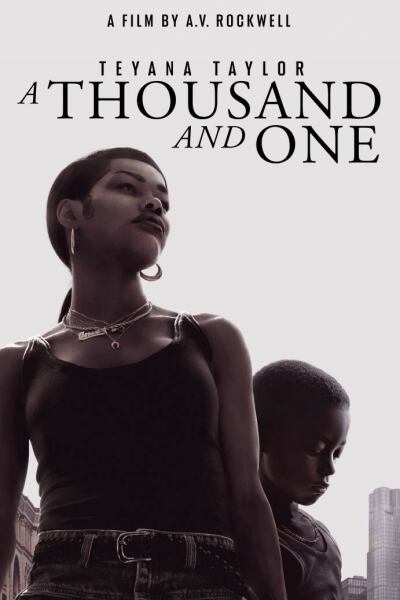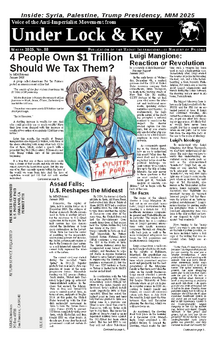
Maoist Movie Review: The Persynal Revolution of Inez de la Paz

Starring Teyana Taylor
Directed by A.V. Rockwell
116 minutes
Rated R
2023
Spoilers
A Thousand and One is a drama film set during the years of 1994-2005 in New York City. The movie follows a hairdresser and recently released prisoner Inez de la Paz (played by New Afrikan rapper/actress Teyana Taylor) who has spent the past years imprisoned in Rikers Island. A persyn who has been part of the foster home system growing up, Inez returns to her former care in Brooklyn where she sees her son, Terry (who is also in a home), out on the streets. Trying to escape from the home, Terry is hospitalized and Inez secretly visits him and takes Terry to illegally raise him as her child under a false birth certificate/social security card in Harlem.
Inez reunites with her former romantic partner/lumpen associate during her times as a petty thief named Lucky. At first, Lucky is hesitant to join in on this plan to build a new family with his former street partner, but eventually marries Inez and promises to take care of Terry. At the time, Pig Rudy Giuliani has begun his campaigns to start an improved New York City which they place much hopes for as life-long residents of NYC.
By 2001, Pig Giuliani’s attacks on the New Afrikan masses of NYC through the stop-and-frisk policies are coming down hard and we see Terry, now a teenager, being affected by this. Despite being a soft-spoken kid excelling at school, the street pigs frisk him and his friend with no other reason than being New Afrikan. Alongside Terry’s entrance into young adulthood, Inez’s marriage begins to meet difficulties as Lucky has become involved in affairs with other wimmin.
By 2005, Lucky succumbs to cancer as Terry prepares for college. The effects of gentrification are beginning to take the offensive against the masses as Euro-Amerikans begin to move in and Inez’s new landlord attempts to drive them out of the apartment using loophole methods to evict them early. In school, Terry’s guidance counselor asks for his birth certificate and social security card for a job program for underprivileged students. Without telling his mother, Terry submits his forged papers which comes back as invalid. After Terry confesses that the government documents were fake, the counselor calls social services who enter Inez’s home. Terry warns his mother about this and she begins to flee as under the imperialist law, despite caring for and stepping up to be the mother for Terry, Inez has committed a kidnapping of a ward of the state. The social services agents reveal to Terry that Inez is not his biological mother and that the two have no real blood relations. The pigs exposes Inez’s lumpen past to Terry leaving him distraught and in tears.
In the end, Inez confesses to Terry the truth. Inez was not the womyn who abandoned Terry on the street corner in his memory. She had found Terry for the first time lost in the streets when she was recently released as a prisoner from Riker’s island. Inez explains to Terry that she saw her younger self in him and that she could not stand to see another child go through the system that she was put through: the foster homes, the juvenile centers, the prisons, etc. Terry, crying, expresses the fear that he feels in becoming independent as he enters adulthood and affirms to Inez that he still loves her as a mother. The two separate on their own paths and before leaving, Inez promises Terry that “this isn’t goodbye.”
Down With Gentrification, Wimmin Hold Up Half the Sky
At the beginning of the movie, we see Inez de la Paz work as a street hawker offering hair/beauty services on the streets. We would say that this is a good portrayal of who we mean when we talk about the First World Lumpen or semi-proletariat who might not participate in overtly anti-people or parasitic ways of self-subsistence (such as sex work or drug peddling) and lives similarly to the semi-proletariat we see in the Third World. In our modern times of the 2020s, we see many folks using social media pages for these grey area side hustles while also maintaining a lower labor aristocrat level minimum wage job (oftentimes in the service industry). In the 1990s when this movie was being set, holding a cardboard box and approaching passer-bys was the common move. Readers might imagine Inez de la Paz to be in an extremely vulnerable political-economic situation as this semi-proletariat/First World Lumpen who had just been released from prison and not much support. However, the movie makes clear that Inez is a tough womyn and avoids both the traps of a damsel in distress needing a male figure out in the dangerous streets nor the over-masculinized New Afrikan womyn whose humynity is stripped away. In an artistic and political sense, we would say the movie did a great job in this regard and is an example we can look up to for creating socialist art/realistic portrayal of the masses under oppression.
Another trap that the movie avoids well is the habit of ruminating on the sensationalist/traumatic pain of New Afrikan life under U.$. imperialism. Mich art which depicts stories of the oppressed nations will fall victim to depicting a suffering masses who suffer like how the sky is blue. A Thousand and One refuses to show Inez, Terry, and Lucky as part of a faceless hoard of suffering while also refusing colorblind individualism: it intertwines the national oppression Black people face (the gentrification, the foster system, the prison system, the education system, etc.) while showing the deeply impersynal effects imperialist institutions have on these very humyn characters and how they take control over their lives without letting the system win. Because of this strong humynization of unapologetically New Afrikan characters, what might seem like a sensationalist plot twist at the end where Inez is revealed to not be Terry’s biological mother is welded to the material reality of the masses’ conditions.
The humnynization of these characters (the foster orphan, the former prisoner, the cheating husband, etc.) that this film undertakes fights against the dehumynization that already exists on these archetypes within the Amerikan imperialist-patriarchal superstructure (especially the oppressed nations and, in this case, principally New Afrika). We as Maoists believe that despite the great storytelling and care that A.V. Rockwell has put in for this story, this film is still part of the U.$. imperialist-patriarchal machine. One persyn and their creation (in this case a film director and her film) will be swept into the wave of the bourgeois superstructure. There will be many Euro-Amerikan viewers of the film who might watch this during February while it is being recommended to them by Netflix in their petty-bourgeois suburbia homes. Would they appreciate/recognize the persynal revolution that Inez has underwent throughout this story? Would they understand the self-determination that Inez has taken over her life against these social forces for the new generation to find happiness? Or would Inez’s motivations and reasons become watered down to a story of the strong independent Black womyn whose intentions were good but her methods of trying to find happiness for Terry was just wrong and too radical? Or worse, they might just paint her as a criminal con artist whose vicarious happiness to a boy she never met gave her a chance to play the act of a mother and a stable family the system eventually took away from her as well. Ms. Rockwell has put great effort into the humynization of these characters, we are afraid that a film alone is not enough to change the consciousness of most people in the level necessity for a society without oppression. That would be a job for a cultural revolution under a proletarian dictatorship.
One thing that interested me as a Maoist revolutionary is the role of motherhood that Inez was able to master over Terry despite her having the knowledge that Terry was not her biological son: a fact that is so overemphasized and shoved down the masses throats when it comes to their legitimate claim over a child. Biological determinism (like in “race”) is a core principle of the imperialist-patriarchial superstructure: gender, motherhood, etc. is determined by one’s bloodline or something they are “born with.” The reality however, is that conditioning of individual by an entire society’s relations of production and class struggle is the true driving force for these roles. For Inez de la Paz, an individual New Afrikan womyn who has recently been released from Rikers Island, to use what she has learned as her life as a lumpen to fight against this broad society’s conditioning and condition herself using individual determination is a great depiction of the social potential of the lumpen class. Historically, abandoning the bourgeois quest of giving orphaned children a nuclear family for them to go into and instead giving them a new environment to live on as orphans has been the successful practice of solving the problem of orphan street kids in the Soviet Union. While a Maoist telling of this story would perhaps depict independent institution building for people like Terry and Inez, the story that is told instead serves good medium for studying and appropriating bourgeois individualism of the Amerikans for the interests of the oppressed nations.
I would like to conclude the review of this movie with two quotes:
“The world is yours, as well as ours, but in the last analysis, it is yours. You young people, full of vigor and vitality, are in the bloom of life, like the sun at eight or nine in the morning. Our hope is placed on you. The world belongs to you. China’s future belongs to you.” - Mao Zedong
“Our revenge will be the laughter of our children” - Bobby Sands








